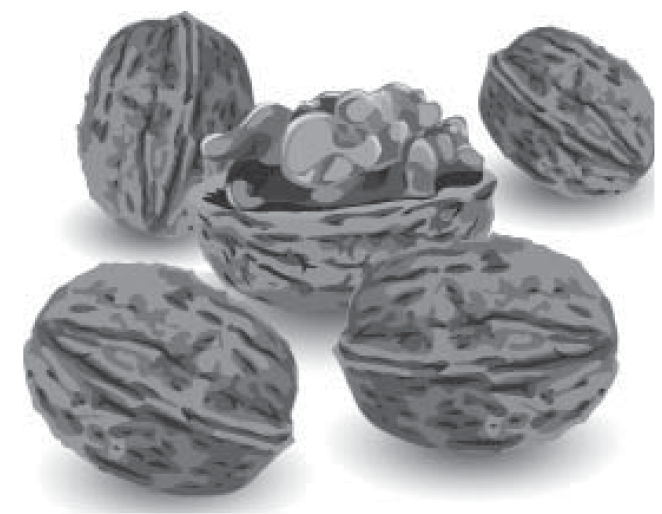 Relevancy and Engagement
dc.agclassroom.org
Relevancy and Engagement
dc.agclassroom.org
A Walnut Orchard Through the Seasons
Grade Level
Purpose
Students discover the changes that take place in a walnut orchard through the seasons by reading and discussing a story about a walnut farm. Grades K-2
Estimated Time
Materials Needed
- Story: Walnut Wonderland, 1 per student
- Reading Activity Sheet: Walnut Wonderland, 1 per student
- Reading Activity Sheet: Walnut Wonderland Answer Key
- Enrichment Activity Sheets (optional)
Vocabulary
canopy: a shade or shelter that grows over something
consumer: a person who buys and uses goods and services
deciduous: during the fall every year, the leaves fall off the tree
dormant: not active but able to become active
fertile: producing vegetation or crops plentifully
harvest: the process or period of gathering crops
hull: the protective outer covering of a fruit or seed
orchard: a place where fruit or tree nuts are grown
pest: an organism living and growing where it is not wanted and is causing damage to plants, humans, structures, and other creatures
pollinate: to carry pollen from the anther to the stigma of a flower
Did You Know?
- Walnuts are the oldest known tree food, dating back to 10,000 BC.1
- There are more than 30 varieties of walnuts.1
- Walnuts contain Omega-3 fatty acids, magnesium, and vitamin E. They are a healthy treat.2
- A healthy walnut tree can produce crops for approzimately 100 years.
Background Agricultural Connections
Walnuts are one of the oldest tree foods known to humans and are good for snacking and cooking. The trees originated in ancient Persia (now known as Iran) where walnuts were reserved for royalty. These walnuts were transported to ports around the world by the English merchant marines and so the “Persian Walnut” came to be called the “English Walnut.” Walnuts were introduced to California by the Franciscan fathers who planted walnut trees in the 1700’s during the establishment of the missions. There are also types of walnut trees that are native to California called California black walnuts. The nuts of one type of black walnut, Northern California black, are used by nurseries for growing rootstock, but black walnut trees are not grown commercially for edible nuts because they are not as good to eat as the English walnut. The eastern black walnut is grown for edible nuts in the Midwestern United States.
California produces 99% percent of all US English walnuts, primarily in the San Joaquin and Sacramento valleys, but also along the Central and Northern Coasts and in the Sierra Foothills. It also supplies three quarters of the world trade. Over 30 different cultivars of the English walnut have been developed for their shell characteristics, walnut meat content, pest tolerance, and harvest time. A cultivar is a plant or grouping of plants selected for desirable characteristics that can be maintained by propagation. The five primary cultivars grown are Chandler, Howard, Hartley, Serr, and Tulare. Walnut trees thrive in fertile, deep, well-drained soil. They begin to bear fruit four to five years after being planted and can continue to grow and bear fruit for a century or more.
Walnuts are harvested using mechanical shakers that shake the nut to the ground during harvest time in September through November. Machines sweep the fallen walnuts into rows, and then the nuts are collected and taken to a processing plant where they are dried, sorted, and cleaned. Walnuts may be sold with their shells intact (“inshell”) or removed (“shelled”). Shelled walnuts are sold whole, in halves, or in pieces of various sizes.
Engage
Inform your students that you will give them a series of "clues." Tell them to use the clues to guess the item you are thinking of.
- It is a type of food.

- It grows on a tree.
- It forms inside a very hard shell.
- They are harvested once per year, usually in the fall.
- They are used mostly in salads and desserts.
- The state of California grows 99% of all that are grown in the United States.
What are they? Walnuts!
In this lesson students will learn about the life cycle of a walnut tree and how farmers grow walnuts.
Explore and Explain
- Distribute the story, Walnut Wonderland to each student.
- Read the story as a class, pausing during each section to discuss the content.
- Write key vocabulary words on the board and discuss the definition as it pertains to agriculture.
- Pass out student activity sheets for reading comprehension and vocabulary. Go through the first two questions together as a class, and then have students complete the rest of the questions on their own.
- After students have completed their activity sheets, instruct them to pair up and compare answers with a partner. Call on groups around the room to check for accuracy.
Elaborate
-
Visit a local walnut orchard on a field trip
-
Ask a walnut farmer to come to class and share what he or she does in the orchard.
-
Ask students to take a blank piece of construction paper (8” x 12”) and divide the paper into four sections. Ask the students to draw a walnut tree in each section to represent each season of the year.
Evaluate
After conducting these activities, review and summarize the following key concepts:
- Walnuts grow on trees.
- California grows almost all of the walnuts grown in the United States.
- Walnut farmers use machines to help them harvest walnuts.
- Walnut trees bloom in the spring. Walnuts are harvested in the fall.
- It's important to have good soil and plenty of water for the walnut trees to be healthy and produce walnuts.
Sources
- http://www.nutritioulicious.com/2010/10/interesting-walnut-facts/
- http://www.superkidsnutrition.com/mt_walnuts/
Acknowledgements
A partnership project of California Walnut Board and California Foundation for Agriculture in the Classroom